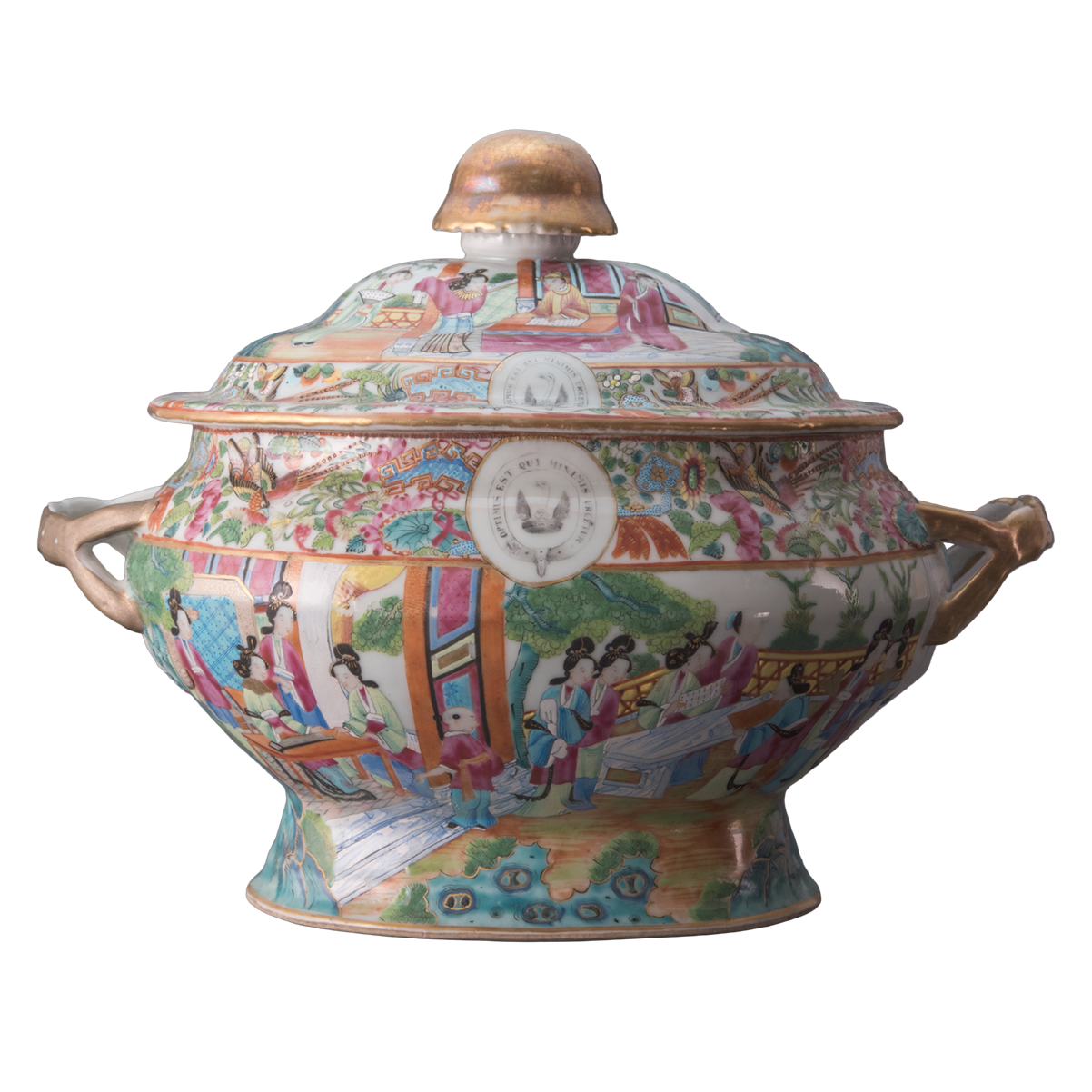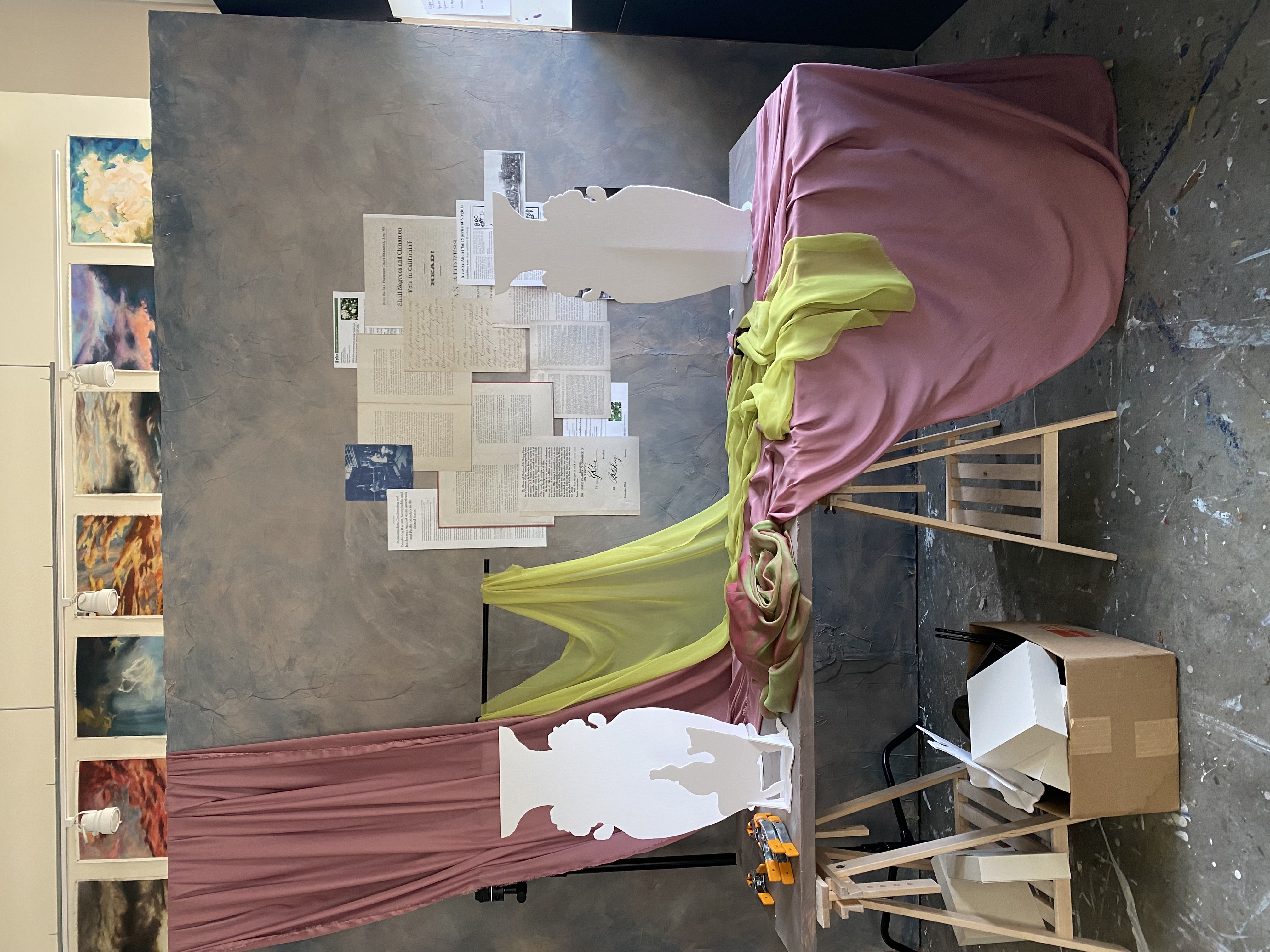美(國)人 (THE ROSE PIECE), 2023
Jump to section ︎︎︎
1. Translating the title, 美(國)人
2. Ceramics
3. Flora
4. Fauna
5. Behind the scenes
6. Documents
1. Translating the title, 美(國)人
美人 (měi rén) means ‘beautiful person’ (usually referring to a woman).The Chinese name for the United States is 美國 (měi guó), which translates as ‘beautiful country’. The origins of this name likely come from a shortening of phonetic transliterations of America: 亞美利加 (yàměilìjiā) or the longer name, 美利堅合眾國 (měilìjiān hézhòngguó), meaning 'The United States of Beauty, Advantage, and Endurance.’
Americans are known as 美國人 (měi guó rén).
A further play on words involves the Chinese name for ‘rose’: 玫瑰 (méi guī), which is a near homophone for ‘beautiful country’ or ‘America’ 美國 (měi guó), as described above. In this way, the English title—The Rose Piece—is linked to its unspoken name: The American Piece.
2. Ceramics
The over 60+ ceramics featured here are all of the related styles of famille rose, Canton rose, and rose medallion. These styles frequently featured bubolic idealizations of Chinese life and people in the designs. Famille rose in Chinese domestic ceramicsware is called 洋彩 (yáng cǎi), ‘foriegn color palette’—it was wildly popular under the Qianlong Emperor (1711–1799), who was a cosmopolitan emperor with an army of Jesuits in his court. Vase
VaseMade in China, 1845–1855
Made of Hard-Paste Porcelain
H. 24.25”, W. 10.375”
Museum purchase with funds provided by W. Groke Mickey, 2015.5.2
 Tureen
TureenMade in China, 1825–1835
Made of Hard-Paste Porcelain
H. 11”, W. 14.25”
Mr. and Mrs. Euchlin D. Reeves Collection in Memory of Mrs. Chester Green Reeves and Miss Lizzie H. Dyer, R1967.1.532ab
Dinner sets with Chinese people on them were especially popular in exportware for Europe and America. Contrast this popularity with the following tidbit from the Museums at Washington and Lee collection. In reference to the Wedgwood plates designed and made in 1939–1940 to commemorate the university is the following discussion:
“This plate is one of a set of eight plates commemorating Washington and Lee. According to an article in the July, 1939, Washington & Lee Alumni Magazine, the plates were designed by John Graham working with a committee consisting of himself, Joseph Lykes, Cy Young, and Stuart Moore, and representatives from Wedgwood. According to the article, the border was designed "specifically to suggest the history, architecture, landscape, flora, etc. of Washington and Lee and its beautiful campus." [...] The decision was made not to include portraits of George Washington or Robert E. Lee because "there are things more appetizing than eating off of other people's faces and that it wouldn't contribute to the success of a dinner party to have Old George peering out at you from a mound of mashed potatoes or to see a wisp of spaghetti festooned over General Lee's moustache and beard." –from the catalogue entry for object 2011.1000.1.1.
 Porcelain Figures
Porcelain FiguresMade in China, 1780–1800
Made of Hard-Paste Porcelain
H. 11.75”, W. 10” and H. 11.5”, W. 8.25”
Donated by Lacy Holdings, Ltd. and its subsidiary, Tyler Street Investments, Ltd. and Mrs. B.W. Crain, Jr., in honor of Rogers Lacy Crain (Class of 1975) and Rogers Lacy Crain, Jr. (Class of 2009), 2009.24.1
 Platter
PlatterMade in China, 1760–1770
Made of Hard-Paste Porcelain
H. 1.25”, W. 12”
Mr. and Mrs. Euclin D. Reeves Collection in Memory of Mrs. Chester Green Reeves and Miss Lizzie H. Dyer, R1967.1.47
 Cruet (from Cruet Set)
Cruet (from Cruet Set)Made in China, 1760–1775
Made of Hard-Paste Porcelain
H. 7”
Gift of Jack Warner, R1981.1.1-5
For a full illustrated checklist of ceramics, see the LONG TIME NO SEE catalogue.
3. Flora
Multiflora rosa (Rosa multiflora), native to eastern Asia, was introduced to the U.S. in 1866 and promoted for soil retention and decorative purposes. Its robust ability to grow in a wide range of environments, however, disrupts native ecosystems, and it is thus designated an invasive species in many states.
Roses were first cultivated in China as early as 3000 BCE, with Confuscian records of the flower in the Imperial Palace in 500 BCE. Rose breeding in Europe gained popularity in the 1800s when Rosa chinensis (China roses) were exported to Europe. Many of today’s garden rose varieties descend from Rosa chinensis species. In Chinese art, roses often symbolize longevity because the Chinese rose has a long blooming season.
4. Fauna
Native to eastern Asia, Asian lady beetles (Harmonia axyridis) were introduced into the U.S. in the early 1900s in an effort to control aphids.
5. Behind the scenes
 Pictured above: an early planning sketch by artist for The Rose Piece.
Pictured above: an early planning sketch by artist for The Rose Piece.

6. Documents
- Plant Conservation Alliance’s Alien Plant Working Group. “Fact sheet: Multiflora Rosa.” [link]
- National Invasive Species Information Center. “Multiflora Rosa.” [link]
- Virginia Department of Conservation and Recreation. “Invasive Alien Plant Species of Virginia.” [link]
- Biden, Joseph R. Jr. 2021. “Memorandum Condemning and Combating Racism, Xenophobia, and Intolerance Against Asian American and Pacific Islanders in the United States (January 26, 2021)” WH.Gov. [link]
- The Burlingame Treaty of 1868 (page 6). [link]
- California Legislature, Senate, Special Committee on Chinese immigration. c. 1877. Chinese immigration: The social, moral and political effect of Chinese immigration. Sacramento, State Printing Office. [link]
- [Photo: Chinese passengers on ferry, c. 1905] [link]
- Pitkin, Horace 2. 1888. “Letter to President Cleveland” (page 4). [link]
- Chinese Exclusion Convention. 1901. For the re-enactment of the Chinese Exclusion Law (pages 4–5). [link]
- 1888. In the Supreme Court of the United States: Chae Chan Ping vs. the United States (pages 14–15). [link]
- Democratic State Central Committee. 1869. Shall Negroes and Chinamen Vote in California? (page 1). Reprinted from the San Francisco Daily Examiner. [link]
- Chinese Chamber of Commerce. 1924. High Lights on Chinese Exclusion and Explusion. The Immigration Law of 1924 As It Affects Persons of Chinese Descent in the United States, Their Business Interests, Their Rights and Their Privileges (page 2). [link]
- [Photo: Earthquake ruins] [link]
- [Photo: Near Portsmouth Square in Chinatown, c. 1888] [link]
︎︎︎PREV
NEXT︎︎︎
